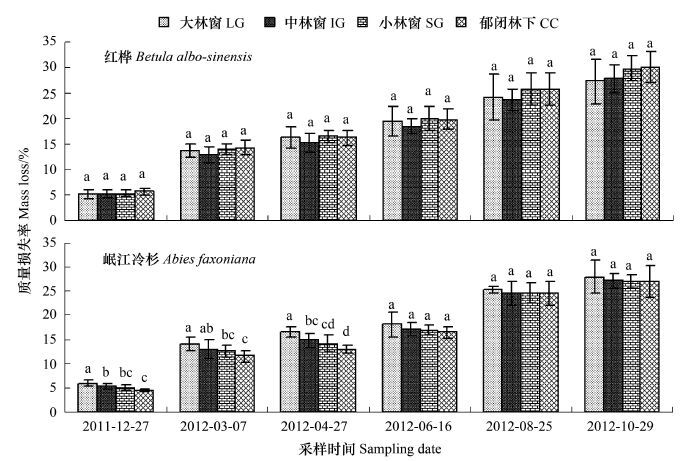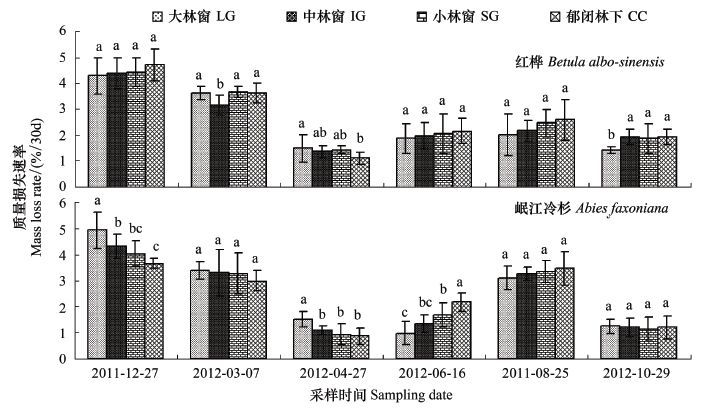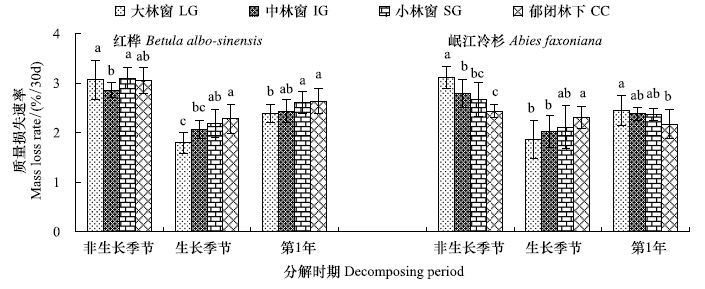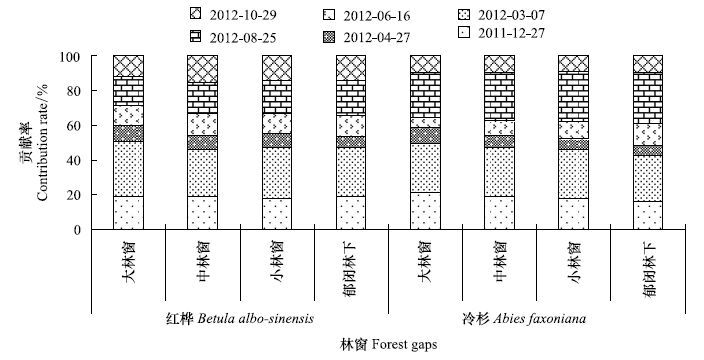文章信息
- 吴庆贵, 吴福忠, 谭波, 杨万勤, 何伟, 倪祥银
- WU Qingui, WU Fuzhong, TAN Bo, YANG Wanqin, HE Wei, NI Xiangyin.
- 高山森林林窗对凋落叶分解的影响
- Effects of gap sizes on foliar litter decomposition in alpine forests
- 生态学报[J]. 2016, 36(12): 3537-3545
- Acta Ecologica Sinica[J]. 2016, 36(12): 3537-3545
- http://dx.doi.org/10.5846/stxb201410192049
-
文章历史
- 收稿日期: 2014-10-19
- 网络出版日期: 2015-05-20
2. 绵阳师范学院, 生态安全与保护四川省重点实验室, 绵阳 621000
2. Ecological Security and Protection Key Laboratory of Sichuan Province, Mianyang 621000, China
林窗是川西高山森林生态系统普遍存在的干扰形式[1]。与郁闭林下相比,林窗改变了林内水热条件(光照、温度、降水)和分解者群落结构[2],可能对凋落物分解过程具有强烈影响。在高寒森林生态系统,不同大小的林窗内冬季雪被厚度和持续时间的变异可能深刻作用于凋落物分解[3-4]。一方面,林窗内雪被的绝热保温作用能使土壤微生物维持相对较高的活性[5];另一方面,郁闭林冠下由于缺乏雪被覆盖,微生物活性受低温和冻结作用抑制[6]。因而,林窗可能促进冬季凋落叶分解,并且不同大小林窗对雪被厚度和冻融循环格局的改变也可能不同程度地作用于凋落叶分解[7-8]。与此相反,尽管生长季节适宜的温湿度条件更有利于凋落物分解,但林窗内相对更高的光照强度和光辐射效率[9]可导致凋落物地表温度升高[10],水分蒸发增加[11],进而影响土壤微生物活性和土壤动物活动能力[12]。因此,相比于郁闭林下,林窗可能抑制生长季节凋落叶分解。这意味着,林窗对高寒森林生态系统不同季节凋落物的分解具有截然不同的影响,但迄今的研究一直缺乏相应的关注,这极大地限制了对高寒森林地下生态过程的认识。
川西高山森林在调节区域气候、涵养水源、保育生物多样性等方面具有突出的战略地位。前期研究表明,林窗是川西高山森林群落最主要的自然更新方式[13],影响凋落物分解的生物和非生物因素与林窗密切相关[14]。因此,可以假设,林窗能显著影响川西高山森林凋落叶分解过程,在冬季促进凋落叶分解,在生长季节制约凋落叶分解;且阔叶和针叶凋落叶对林窗的响应不同。为验证上述假设,本研究采用凋落物分解袋法,以区域内代表性针叶树种岷江冷杉(Abies faxoniana)和阔叶树种红桦(Betula albo-sinensis)凋落叶为研究对象,研究林窗面积大小对针、阔树种凋落叶在非生长季节和生长季节分解的影响,以期为深入认识高寒森林生态系统物质循环过程提供科学依据。
1 材料与方法 1.1 研究区域与样地概况研究区域位于四川省理县毕棚沟自然保护区(31°14′—31°19′ N,102°53′—102°57′ E,2458—4619 m a.s.l.),地处青藏高原东缘与四川盆地的过渡带。年平均气温2—4℃,最高气温23℃ (7月),最低温度为-18℃ (1月),年降水量约850 mm。该区域冬季具有明显的季节性雪被覆盖和冻融过程,雪被厚度达50 cm,冻融时间长达约120 d[3]。区域内典型植被为岷江冷杉(A. faxoniana) 、红桦(B. albo-sinensis)和川西云杉(Picea balfouriana)。土壤为发育于坡积物上的雏形土,基本理化性质见杨玉莲等[15]。
基于前期研究,在海拔3598m 原始岷江冷杉林内设置1 hm2样地(坡向NE 38°,坡度24°)。乔木层岷江冷杉占据绝对优势,其次是红桦,伴生少量野樱桃(P. tatsienensis);灌木主要有高山杜鹃(Rhododendron delavayi)、三颗针(Berberis sargentiana)和绢毛蔷薇(Rosa sericea)等;草本以铁线莲(Clematis)、苔草(Carex)和羊茅(Festuca)等为主,林窗内草本盖度约85%。按照林窗面积大小在样地内分别选取大林窗(large gap,LG)、中林窗(intermediate gap,IG)和小林窗(small gap,SG)各3个。同时,在岷江冷杉郁闭林下(the closed canopy,CC)设置3个10 m×10 m的样方作为对照。然后调查林窗的基本性质 (表 1),并进行整理和清除工作。
| 林窗类型 Types of gap | 林窗面积/m2 Area of gap | 形成木 Species of gap maker | 边界木 Species of gap border | 形成方式 Gap formation types |
| 大林窗Large gap | 255.16—290.41 | 岷江冷杉 Abies faxoniana | 岷江冷杉Abies faxoniana、 红桦Betula albo-sinensis | 折干 Beakage at trunk |
| 中林窗Intermediate gap | 153.36—176.43 | |||
| 小林窗Small gap | 38.25—46.58 |
2011年秋季搜集岷江冷杉和红桦新鲜凋落叶,室温下自然风干,称取10 g风干凋落叶装入分解袋(大小为20 cm×20 cm,贴地面孔径0.50 mm,上表面孔径1 mm),于2011年11月埋设于样地,分解试验为期1a,共埋设分解袋1440袋=每次取样 (10) × 林窗 (4) × 3 (重复) × 2 (物种) × 6次。同时,采用纽扣式温度记录器(iButton DS1923-F5,Maxim/Dallas Semiconductor,Sunnyvale,USA)记录空气和各林窗下凋落袋内温度,设定每2 h记录1次温度数据。此外,采用钢尺测量各海拔林窗及林下雪被厚度。各林窗温度和雪被变化见图 1、图 2和表 2。

|
| 图 1 不同林窗下的日平均温度 Fig. 1 Daily means temperature in sampled gaps and the closed canopy |

|
| 图 2 不同大小林窗和郁闭林下的雪被厚度 Fig. 2 Snow depths in forest gaps and the closed canopy |
| 林窗类型 Types of gap | 初冻期 Onset of soil freezing period | 深冻期 Soil deep freezing period | 融化期 Soil thawing period | 生长初期 Early growth period | 生长中期 Mid-growing period | 生长后期 Later growth period |
| 大林窗Large gap | -0.56±0.16 a | -1.39±0.19 a | 2.98±0.41 a | 9.78±1.04 a | 12.51±0.41 a | 7.94±0.74 a |
| 中林窗Intermediate gap | -1.60±0.13 b | -2.12±0.29 b | 2.16±0.36b | 9.40±1.08 a | 12.34±0.54ab | 5.68±0.51 b |
| 小林窗 Small gap | -1.98±0.15 c | -2.13±0.33 b | 1.95±0.34 b | 6.16±0.96 b | 11.63±0.44 b | 5.66±0.63 b |
| 郁闭林下 Closed canopy | -2.40±0.12 d | -3.14±0.45 c | 0.59±0.14 c | 6.04±0.53 b | 10.13±0.55 c | 4.37±0.55 c |
| 不同小写字母表示差异显著(独立样本t检验,P < 0.05) | ||||||
根据前期监测,按高山植物的物候期分非生长季节(冬季)和生长季节进行样品采集,具体为:非生长季节的初冻期(12月27日,onset of soil freezing period,OF)、深冻期(3月7日,soil deep freezing period,DF)、融化期(4月27日,soil thawing period,TP);生长季节的初期(6月16日,early growth period,EP)、中期(8月25日mid-growing period,MP)和后期(10月29日,later growth period,LP)。每次采样时随机从每个样方捡回10袋凋落叶,去除杂物后,于65℃烘干至恒重并称量,计算凋落叶失重率。2种凋落叶的初始化学特征见表 3。
| 物种 Species | 碳/(g/kg) Organic carbon | 氮/(g/kg) Nitrogen | 磷/(g/kg) Phosphorus | 碳比氮C/N | 木质素比氮 Lignin/N |
| 红桦Betula albo-sinensis | 484.27b±17.00 | 10.41b±0.79 | 0.82b±0.08 | 46.52a±1.76 | 25.86a ±0.45 |
| 岷江冷杉Abies faxoniana | 505.85a±30.64 | 11.43a±1.11 | 1.71a±0.11 | 44.26a ±2.01 | 19.81b ±0.39 |
半分解时间(T50%)、95%分解时间(T95%)、质量损失率和质量损失速率[16-17]按如下公式计算:

|
式中,Mt为t时刻凋落叶干质量(g),M0为初始干重(g),(Mt-1-Mt)为相邻采样时间凋落叶残留量差(t=1,2,3,…,6) ,DΔt为相邻采样时间间隔天数。
用单因素方差分析(one-way ANOVA)检验凋落叶日均温、质量损失率、损失速率在不同林窗间的差异显著性;用Pearson相关分析检验日均温、冻融循环次数与质量损失速率之间的相关关系。显著性水平设为P = 0.05,数值以平均值±标准误(mean ± SE)表示。数据分析采用SPSS 20.0 (IBM SPSS Statistics Inc.,Chicago,IL,USA)软件包进行。
2 结果与分析 2.1 质量损失率分解1a后,红桦和的岷江冷杉凋落叶质量损失率分别为27.25—30.12%和27.04—27.96% (图 3)。2种凋落叶半分解和95%分解时间分别为2.015—2.413 a、2.110—2.557 a和8.708—10.428 a、9.121—11.053 a,红桦凋落叶分解周期随林窗面积增加而增加,岷江冷杉凋落叶则相反(表 4)。与郁闭林下相比,林窗形成显著(P<0.05) 影响非生长季节(初冻期、深冻期和融化期)岷江冷杉凋落叶的质量损失率,且林窗面积越大其质量损失率越高;而对红桦凋落叶质量损失率无显著影响(P>0.05) 。

|
| 图 3 不同大小林窗和郁闭林下的凋落叶质量损失 Fig. 3 Mass losses of foliar litter in forest gaps and the closed canopy |
| 物种 Species | 林窗类型 Types of gap | 回归方程 Regression models | 分解系数k Decomposition constant k | 相关系数R2 Correlation coefficient R2 | 半分解时间/a Time of half decomposition | 95%分解时间/a Time of 95% decomposition |
| 红桦 | 大林窗 | y=96.476e-0.287t | 0.287 | 0.987 | 2.413 | 10.428 |
| Betula albo-sinensis | 中林窗 | y=97.412e-0.306t | 0.306 | 0.994 | 2.266 | 9.794 |
| 小林窗 | y=96.927e-0.321t | 0.321 | 0.991 | 2.157 | 9.324 | |
| 郁闭林下 | y=97.503e-0.344t | 0.344 | 0.995 | 2.015 | 8.708 | |
| 岷江冷杉 | 大林窗 | y=97.494e-0.328t | 0.328 | 0.992 | 2.110 | 9.121 |
| Abies faxoniana | 中林窗 | y=97.684e-0.307t | 0.307 | 0.993 | 2.256 | 9.751 |
| 小林窗 | y=97.182e-0.283t | 0.283 | 0.986 | 2.449 | 10.585 | |
| 郁闭林下 | y=97.286e-0.271t | 0.271 | 0.980 | 2.557 | 11.053 |
2种凋落叶分解速率总体上呈现逐渐减慢再增加的趋势(图 4)。林窗形成显著(P<0.05) 影响了深冻期、融化期和生长后期红桦凋落叶的质量损失速率,显著增加了融化期质量损失速率,且随林窗面积增大而增加。对岷江冷杉而言,林窗形成显著(P<0.05) 影响了初冻期、融化期和生长初期凋落叶的质量损失速率。林窗形成后显著(P<0.05) 增加了初冻期、深冻期和融化期岷江冷杉凋落叶的质量损失速率,且质量损失速率随林窗面积增大而增加;显著降低了减小降低了生长季节后期岷江冷杉凋落叶的质量损失速率,且质量损失速率随林窗面积增大而降低。

|
| 图 4 不同大小林窗和郁闭林下的凋落叶分解速率 Fig. 4 Mass loss rates of foliar litter in forest gaps and the closed canopy |
由图 5可得,林窗显著(P<0.05) 影响了2种凋落叶第1年的质量损失速率。林窗形成后显著降低了2种凋落叶第1年生长季节质量损失速率,且林窗面积越大质量损失速率越低;显著增加了红桦凋落叶非生长季节和岷江冷杉凋落叶非生长季节以及第1年的质量损失速率,且林窗面积越大质量损失速率越高。总体上,2种凋落叶质量损失速率在第1年非生长季节显著(P<0.05) 高于生长季节。

|
| 图 5 冬季和生长季节凋落叶分解速率 Fig. 5 Mass loss rates of foliar litters in forest gaps and the closed canopy in winter and the growing season |
由图 6可得,2种凋落叶各关键时期质量损失所占比例为第1年深冻期>生长中期>初冻期>生长初期>生长后期>融化期。4种不同面积林窗内(从大林窗、中林窗、小林窗到林下)红桦和岷江冷杉凋落叶第1年非生长季节质量损失分别占第1年的60.18%、54.46%、55.34%、53.83%和59.09%、54.37%、52.22%、50.23%,非生长季节显著(P<0.05) 高于生长季节。

|
| 图 6 各关键时期质量损失在全年分解过程中所占的比率 Fig. 6 Ratios of mass losses at each critical stage compared to the entire decomposition year |
与假设基本一致,川西高山森林林窗对凋落叶分解有显著影响:促进了冬季凋落叶分解,抑制生长季节的凋落叶分解,尤其是对岷江冷杉凋落叶分解过程作用更为明显。一方面,林窗面积越大,冬季形成雪被的厚度也越厚,林窗内雪被覆盖的时间也越长(图 2),雪被的保温作用能持续促进凋落叶分解。并且,大林窗内的凋落叶在雪被融化期可接收更多雪融水和降水的淋洗作用,促进凋落叶内可溶解性组分的流失。另一方面,在生长季节,由于缺乏林冠对光照的过滤和拦截作用,林窗内的太阳辐射显著高于郁闭林下,且这种作用随林窗面积增加和增强[18]。这促进了林窗内凋落叶水分的蒸发,不利于土壤无脊椎动物和微生物对凋落物分解的贡献,进而抑制凋落叶分解。这表明林窗形成对微环境的改变能深刻影响高寒森林地下生态系统的物质循环。
在高寒森林生态系统中,尽管冬季低温不利于土壤动物[19]和微生物[17]对凋落叶的降解,但季节性雪被[3]和冻融循环[14, 16]能显著作用于冬季凋落叶分解。已有的研究表明,雪被融化的淋洗作用和冻融循环的物理破碎[3, 14, 16]都能显著促进凋落叶分解。同时,雪被覆盖环境中存活的土壤动物[20-21]和微生物活性[5]也能促进冬季凋落叶分解。本研究中,红桦和岷江冷杉冬季凋落叶分解占全年分解的比例分别为53.83%—60.18%和50.23%—59.09%,高于生长季节(图 6)。这说明冬季凋落叶分解对高山森林物质循环具有十分重要的作用[17]。另一方面,林窗形成能改变雪被环境、土壤冻融格局[22]和耐寒微生物的活性[23],直接或间接影响冬季凋落叶分解[12]。本研究中,林窗形成显著提高了非生长季节2种凋落叶质量损失速率。地表凋落叶日均温度和土壤冻融循环与深冻期等关键时期质量损失速率显著相关(表 5),这表明林窗形成改变了林窗内冬季环境条件,对川西高山森林冬季凋落叶分解产生了重要影响[2, 24]。
| 类别 Types | 物种Species | 初冻期 Onset of soil freezing period | 深冻期 Soil deep freezing period | 融化期 Soil thawing period | 生长初期 Early growth period | 生长中期 Mid-growing period | 生长后期 Later growth period |
| 日均温 (T) | 红桦 Betula albo-sinensis | -0.201 | 0.607** | 0.687** | -0.139 | -0.236 | 0.077 |
| Average temperature | 岷江冷杉 Abies faxoniana | 0.691** | 0.422* | -0.230 | 0.564** | -0.182 | -0.007 |
| 冻融循环 (F) | 红桦 Betula albo-sinensis | -0.173 | 0.151 | 0.355* | 0.079 | - | 0.085 |
| Frequency of soil freeze-thaw cycle | 岷江冷杉 Abies faxoniana | 0.581** | 0.587** | 0.650** | 0.280 | - | 0.023 |
| * P<0.05; ** P<0.01 | |||||||
林窗对凋落物分解的影响常常随林窗面积大小而发生变化,但已有的研究结果具有不确定性[24-28]。有研究者发现,大林窗中凋落物的质量损失速率比小林窗和林下低[25-26],也有研究者认为林窗面积大小对凋落物分解影响不显著[27-28],甚至在大林窗中凋落物分解更快[29]。本研究发现,在1a分解过程中,2种凋落叶在生长季节的质量损失速率随林窗面积增加而减小,在非生长季节的岷江冷杉凋落叶以及融化期的红桦凋落叶的质量损失速率随林窗面积增加而增加,而初冻期和深冻期红桦凋落叶质量损失速率在不同面积林窗内差异不显著(中林窗除外)。如前所述,不同面积林窗由于冬季雪被覆盖以及生长季节水分蒸发量差异等限制着分解者群落的定着,直接影响林内凋落叶的分解过程。研究表明,凋落物质量(quality)是植物残体自身分解的关键因子[30],控制着中小尺度上凋落物的分解过程[31]。本研究中红桦和岷江冷杉分别是阔叶和针叶凋落叶,其基质质量存在显著差异(表 3),因此对环境变化的响应过程和时间也存在不同(图 3)。综上所述,川西高山森林林窗面积大小对凋落叶分解产生显著影响,且阔叶和针叶凋落叶在非生长季节与生长季节对林窗的响应存在明显差异。
| [1] | 吴庆贵, 吴福忠, 杨万勤, 谭波, 杨玉莲, 倪祥银, 何洁.川西高山森林林隙特征及干扰状况.应用与环境生物学报,2013,19(6): 922–928. |
| [2] | Sariyildiz T.Effects of gap-size classes on long-term litter decomposition rates of beech, oak and chestnut species at high elevations in Northeast Turkey.Ecosystems,2008,11(6): 841–853. |
| [3] | 何伟, 吴福忠, 杨万勤, 武启骞, 何敏, 赵野逸.雪被斑块对高山森林两种灌木凋落叶质量损失的影响.植物生态学报,2013,37(4): 306–316. |
| [4] | 倪祥银, 杨万勤, 李晗, 徐李亚, 何洁, 吴福忠.雪被斑块对川西亚高山森林6种凋落叶冬季腐殖化的影响.植物生态学报,2014,38(6): 540–549. |
| [5] | 周晓庆, 吴福忠, 杨万勤, 朱剑霄.高山森林凋落物分解过程中的微生物生物量动态.生态学报,2011,31(14): 4144–4152. |
| [6] | Matulich K L, Martiny J B H.Microbial composition alters the response of litter decomposition to environmental change.Ecology,2014 |
| [7] | Bokhorst S, Metcalfe D B, Wardle D A.Reduction in snow depth negatively affects decomposers but impact on decomposition rates is substrate dependent.Soil Biology and Biochemistry,2013,62 157–164. |
| [8] | Wu Q Q, Wu F Z, Yang W Q, Zhao Y Y, He W, Tan B.Foliar litter nitrogen dynamics as affected by forest gap in the alpine forest of Eastern Tibet Plateau.PLoS One,2014,9(5): e97112. |
| [9] | Hu L L, Zhu J J.Improving gap light index (GLI) to quickly calculate gap coordinates.Canadian Journal of Forest Research,2008,38(9): 2337–2347. |
| [10] | Latif Z A, Blackburn G A.The effects of gap size on some microclimate variables during late summer and autumn in a temperate broadleaved deciduous forest.International Journal of Biometeorology,2010,54(2): 119–129. |
| [11] | Herbst M, Roberts J M, Rosier P T W, Taylor M E, Gowing D J.Edge effects and forest water use:A field study in a mixed deciduous woodland.Forest Ecology and Management,2007,250(3): 176–186. |
| [12] | Montti L, Campanello P I, Gatti M G, Blundo C, Austin A T, Sala O E, Goldstein G.Understory bamboo flowering provides a very narrow light window of opportunity for canopy-tree recruitment in a neotropical forest of Misiones, Argentina.Forest Ecology and Management,2011,262(8): 1360–1369. |
| [13] | 刘庆, 吴彦.滇西北亚高山针叶林林窗大小与更新的初步分析.应用与环境生物学报,2002,8(5): 453–459. |
| [14] | Wu F Z, Yang W Q, Zhang J, Deng R J.Litter decomposition in two subalpine forests during the freeze-thaw season.Acta Oecologica,2010,36(1): 135–140. |
| [15] | 杨玉莲, 吴福忠, 杨万勤, 谭波, 徐振锋, 刘洋, 康丽娜.雪被去除对川西高山冷杉林冬季土壤水解酶活性的影响.生态学报,2012,32(22): 7045–7052. |
| [16] | Baptist F, Yoccoz N G, Choler P.Direct and indirect control by snow cover over decomposition in alpine tundra along a snowmelt gradient.Plant and Soil,2010,328(1/2): 397–410. |
| [17] | Zhu J X, He X H, Wu F Z, Yang W Q, Tan B.Decomposition of Abies faxoniana litter varies with freeze-thaw stages and altitudes in subalpine/alpine forests of southwest China.Scandinavian Journal of Forest Research,2012,27(6): 586–596. |
| [18] | 王进欣, 张一平, 马友鑫, 刘玉洪, 李佑荣, 段文平.西双版纳人工林林窗光照剖线分布特征.植物资源与环境学报,2000,9(1): 27–30. |
| [19] | 罗媛媛, 袁金凤, 沈国春, 赵谷风, 于明坚.常绿阔叶林片段中木荷凋落叶分解速率及中小型土壤节肢动物群落的结构动态.应用生态学报,2010,21(2): 265–271. |
| [20] | Christenson L M, Mitchell M J, Groffman P M, Lovett G M.Winter climate change implications for decomposition in northeastern forests:comparisons of sugar maple litter with herbivore fecal inputs.Global Change Biology,2010,16(9): 2589–2601. |
| [21] | 刘瑞龙, 李维民, 杨万勤, 谭波, 王文君, 徐振锋, 吴福忠.土壤动物对川西高山/亚高山森林凋落物分解的贡献.应用生态学报,2013,24(12): 3354–3360. |
| [22] | Varhola A, Coops N C, Weiler M, Moore R D.Forest canopy effects on snow accumulation and ablation:An integrative review of empirical results.Journal of Hydrology,2010,392(3): 219–233. |
| [23] | Clein J S, Schimel J P.Microbial activity of tundra and taiga soils at sub-zero temperatures.Soil Biology and Biochemistry,1995,27(9): 1231–1234. |
| [24] | Prescott C E, Hope G D, Blevins L L.Effect of gap size on litter decomposition and soil nitrate concentrations in a high-elevation spruce fir forest.Canadian Journal of Forest Research,2003,33(11): 2210–2220. |
| [25] | Zhang Q S, Zak J C.Effects of gap size on litter decomposition and microbial activity in a subtropical forest.Ecology,1995,76(7): 2196–2204. |
| [26] | Ritter E.Litter decomposition and nitrogen mineralization in newly formed gaps in a Danish beech (Fagus sylvatica) forest.Soil Biology and Biochemistry,2005,37(7): 1237–1247. |
| [27] | Thompson J, Proctor J, Scott D A, Fraserb P J, Marrsc R H, Millerd R P, Vianae V.Rain forest on Maracá Island, Roraima, Brazil:artificial gaps and plant response to them.Forest Ecology and Management,1998,102(2/3): 305–21. |
| [28] | Denslow J S, Ellison A M, Sanford R E.Treefall gap size effects on above-and below-ground processes in a tropical wet forest.Journal of Ecology,1998,86(4): 597–609. |
| [29] | Prescott C E, Blevins L L, Staley C L.Effects of clear-cutting on decomposition rates of litter and forest floor in forests of British Columbia.Canadian Journal of Forest Research,2000,30(11): 1751–1757. |
| [30] | Köchy M, Wilson S D.Litter decomposition and nitrogen dynamics in aspen forest and mixed-grass prairie.Ecology,1997,78(3): 732–739. |
| [31] | Berg B, Berg M P, Bottner P, Box E, Breymeyer A, de Anta R C, Couteaux M, Escudero A, Callardo A, Kratz W, Madeira M, Mälkönen E, McClaugherty C, Meentemeyer V, Muñoz F, Piussi P, Remacle J, de Santo A V.Litter mass loss rates in pine forests of Europe and Eastern United States:some relationships with climate and litter quality.Biogeochemistry,1993,20(3): 127–159. |
 2016, Vol. 36
2016, Vol. 36




